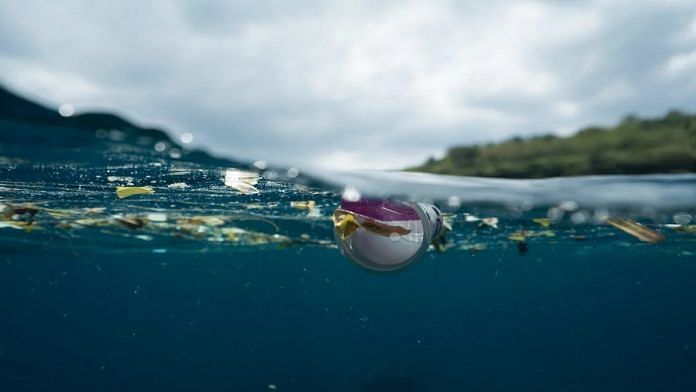Bengaluru: Small relatives of jellyfish, molluscs and other coastal marine invertebrates appear to be living and reproducing on mounds of plastic debris in the middle of the Pacific Ocean, a group of American, Canadian and Dutch researchers has found.
These organisms were discovered on the Great Pacific Garbage Patch — a large ‘island’ of human detritus spanning 1.5 million square kilometres, located between Hawaii and California — living on pieces of flotsam comprising fishing gear, nets, and discarded rope among other items. What’s more, they were coexisting with oceanic species.
The researchers identified over 450 marine organisms in this lot, with a majority being coastal species. Their findings were published in the peer-reviewed journal Nature Ecology & Evolution Monday.
A commentary article on the phenomenon, by the same authors, was published in the journal Nature Communications in December 2021. In the latest study, the researchers have published the data they have collected.
While some marine invertebrates are known to float throughout the open ocean on debris, the extent to which organisms use plastic as their permanent home surface has been unclear until now. Plastic debris can be a good ‘home’ as long as the surface does not disintegrate.
These organisms were found to survive in high densities and diversity on the surfaces of discarded rope and fishing nets, while feeding on smaller organisms like plankton and algae, the researchers found.
The study’s authors suggest that the discovery shows coastal organisms are capable of long-term survival and reproduction on floating plastic hundreds of kilometres away from the coast, and that these findings are evidence of a new type of ecological community in the ocean, which they call the ‘neopelagic community’.
Also Read: From spoons to flags, how govt’s plastic ban aims to phase out ‘low-utility’ single-use items
Living on bottles, ropes & fishnets
The process by which organisms hitch a ride on floating debris and live on it is called ‘rafting’. It is a widespread phenomenon, but is not well studied or characterised. Typically, raft material tends to be floating vegetation or pumice stones from volcanic regions.
Natural materials, including glass and metal, decompose quickly in the open sea. But plastics survive upto thousands of years. These plastics are used in fishing gear to make ropes, floats, fishing nets, etc.
Floating pieces of trash collect at the Great Pacific Garbage Patch due to the Eastern North Pacific Subtropical Gyre currents — large ocean currents in circulatory patterns — which gather them in one place.
To understand the extent to which marine organisms use plastic waste as their home, the team collected 105 items across ten categories — rope, net, buoy, crate, eel trap, fragment, jug/bucket, bottle, household items, and others. The items were at various stages of disintegration, including debris that looked new and ones that had likely been floating for many years, if not decades.
The items were collected between November 2018 and January 2019, and most pieces of debris were unidentifiable. Some pieces had markings that indicated they were manufactured in Japan and North America.
The most diversity of species was found on ropes, followed by nets and bottles, and nearly all species were of the Northwest Pacific origin (including native Japanese coastal species).
Pelagic or oceanic species were found on nearly 95 per cent of debris items, but coastal species were present on over 70 per cent of debris, hundreds of kilometres into the ocean. The organisms coexisted on the same pieces of plastic.
A total of 484 specimens of invertebrates were collected, with over 80 per cent of them being coastal organisms. Organisms were found at various stages of their life cycles, indicating that breeding was actively taking place in these environments, including as sexual reproduction.
The authors propose a name for the ecosystem — a neopelagic community — which is characterised by coastal and pelagic species living together, with coastal ones having the ability to survive for many years but not having developed a reproductive strategy to become permanent colonists.
“The plastisphere may now provide extraordinary new opportunities for coastal species to expand populations into the open ocean and become a permanent part of the pelagic community, fundamentally altering the oceanic communities,” reads the study.
Transparent islands of plastic
Floating waste in the ocean gets moved around through ocean currents, accumulating within gyres in circulatory patterns.
The Great Pacific Garbage Patch actually consists of two patches — the western patch off the coast of Japan and the eastern off the coast of California — joined by a section of plastic. Together, this region consists of 90 million metric tonnes of garbage with over 35 million individual items.
While the patch does have the highest density of plastic refuse anywhere in the world, garbage patches consist of free-floating garbage with individual pieces floating separately. The plastic is also not restricted to the surface — a large part of the garbage patch exists under the surface, floating as micro plastics in the water column, extending to 30 metres or 100 feet below.
There are a total of 5 identified garbage patches, which exist on the five notable ocean gyres — the Great Pacific Garbage Patch, the North Atlantic garbage patch between North America and Africa, the South Atlantic garbage patch between South America and Africa, the South Pacific garbage patch off the coast of South America, and the Indian Ocean garbage patch off the coast of Africa.
(Edited by Gitanjali Das)
Also Read: More than 170 trillion pieces of plastic are choking oceans worldwide, finds US institute



